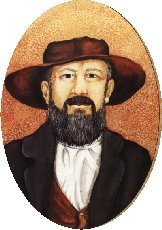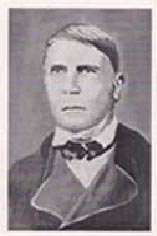
|
Louis Trichardt |
| www.boerafrikana.com: Tuisblad > |
|
| LOUIS TRICHARDT se geselskap en dié van Lang Hans van Rensburg was die eerste wat die uittog uit die Kolonie na die noorde aangedurf het. Met hul trekke was hulle baanbrekers in ’n ruwe en onontwikkelde land.
Die dorp Louis Trichardt, aan die voet van die Soutpansberg in die provinsie Limpopo, is in 1899 gestig en na die ou Voortrekkerleier genoem, wat tydens sy veelbewoë trek ook daar naby vertoef het. Beswaardes het hul verset teen die dorp se naamsverandering na Makhado, die naam van ’n negentiende-eeuse Venda-koning, tot in die Appèlhof gevoer. Die naamsverandering (in 2003) is in 2007 deur die hof ongedaan gemaak.
Teks van www.mieliestronk.com besoek op Okt 23, 2010
Louis Trichardt, Voortrekker leader and diarist, was born in Cango on the 10th August 1783 and died at Lourenco Marques, in October 1838. The first South African ancestor of the Trichardts (according to the Cape muster-rolls) was Carel Gustaav Tregard, who was born in Synnesby and settled in Kvidinge, near Angelholm, in South-ern Sweden, and probably arrived at the Cape in 1742, for his name appears on the muster-rolls of that year as a sailor. Later he is referred to as a flagman on Signal Hill.On 11 October 1744, he married Susanna Kuun at Cape Town and, when he died on 19 September 1767, he was a free burgher at Stellenbosch. At the Cape the Swedish family name was rendered in Dutch in various forms such as Trigaardt, Triegaart, Tregart, Trigart, Triegard, Tregardt. The Voortrekker leader consistently wrote ` Tregardt ‘; but, round about 1882, `Trichardt’ was the form adopted by his son Carolus, because of a supposed French origin. Louis was baptised on 10 April 1785 at Paarl and the baptismal register (where the spelling was usually left to the parish clerk or the minister) records that his father was Karel Johannes Trigaart and his mother Anna Elizabeth Nel. On 4 November 1810, Louis married Martha Elizabeth Susanna Bouwer at Graaff-Reinet and their eldest son, Carolus, married Cornelia Bouwer. The other children were Petrus Frederik, Louis, Anna Elizabeth and Jeremias. The last died in Portuguese territory in 1838. Trichardt's journal shows that he had had a better education than the general run of frontier farmers, so that he wrote fairly correct Dutch. For his time he was a man of wide reading, with his own small collection of books. There is no reliable picture showing his build and appearance, but it appears that he was a muscular six-footer, with dark hair, strong features and a slightly hooked nose. By nature he was calm and deliberate, although some English records state the opposite. Perhaps he was more impetuous in his youth, as may be assumed from the fact that he was always at the outposts and was among those who crossed the frontier of the colony and penetrated far into the interior. He impressed people with his strong personality and he inspired confidence. As a boy, he knew turbulent times. His father played a leading part in the resistance against the Dutch East India Company (1792-1794) and against British rule (1795- 1800). Relatives and friends of the Trichardts were among the rebels who were hanged at Slachter’s Nek in 1816. That Louis was a supporter of the House of Orange is evident from a verse in his journal dedicated to King William I of the Netherlands. Trichardt farmed in various parts of the Uitenhage and Graaff-Reinet districts. After his marriage in 1810 he developed his famous farm Boschberg, the site of the present town of Somerset East, where Lord Charles Somerset in 1814 laid out an experimental farm for the Eastern Province. In 1826, Louis and his son Carel (Carolus) acquired adjacent farms, Elizabeth and Klipplaat, on the Riet River, 30 km south of present-day Bedford. The previous year he had been made acting field-cornet of the Smaldeel ward, but he suffered under all the weaknesses of the colonial administration in the face of the incursions of the Xhosas, and his grievances mounted. Shortly after 1830 Trichardt sent most of his cattle (under the care of 18-year-old Carel) deep into Bantu territory. He himself followed in 1833 and settled temporarily north of the present mission station of St. Mark’ s in Tembuland. The Trichardts, however, were not alone. About 30 other farmer families also settled there and excellent relations developed between the paramount chief, Hintsa, and Trichardt. This relationship was so good that on the outbreak of the frontier war of 1834 the British accused Trichardt of inciting Hintsa against the colonial government. It was said that Trichardt had trekked north because he feared British reprisals. The idea of trekking to the north did not occur suddenly, however, although a decision was probably hastened when, in the fresh border clash, Trichardt found himself in a very awkward position. Although he had acquired right of occupation for 99 years from Hintsa, it is hard to believe that this freedom-loving man ever intended to remain permanently subject to a Xhosa chief. The date of his departure from the Eastern Province is unknown, but it can be assumed that it was about April or May 1835. He maintained his claim to farms in the Cape Colony by paying the taxes on them. These were paid up to the end of 1839, a year after his death.
Trichardt ‘ s trek and his expedition to Delagoa Bay occupy a special place in the annals of South Africa. He was one of the earliest explorers of the Transvaal and he blazed the trail for the Great Trek. His wanderings from the Colony to Delagoa Bay took three years and he kept two journals of this epic journey. The first part, dealing with the journey to the Zoutpansberg, has been lost. The second part contains daily notes on the trek from Zoutpansberg to Lourenco Marques, from about July 1836 to 1 May 1838. Trichardt was the only Trek leader who kept a diary and it is one of the most valuable pieces of Africana. His clear handwriting makes a favourable impression and the reader comes to know him as a calm, level-headed man with a keen sense of humour. His ability as a leader is evident from the fact that after a trek of three years he arrived safely with his followers, animals and wagons at the Portuguese sea-port. He understood the aborigines and his tactful treatment of them enabled him to journey safely through the territories of warlike tribes. Having acquired a reputation for fair dealing, he was often consulted about feuds between the tribes. His relationship with the Portuguese district governor, Capt. Antonio Gamitto, was such that he won the esteem of the small settlement. He stayed with the governor in the fort and probably died there. He was buried beside his wife on the hill above Lourenco Marques; she had died in the fort on 1 May 1838 and his journal gives a moving account of her illness and death. Trichardt was a pioneer and explorer without fear or hate, but he suffered from a sense of injustice, which led him into the wilds, where he sought a place where he and his people could live in peace. His journal was edited and published, with a detailed introduction, by GS Preller in 1917 and, more scientifically from a philological point of view, by TH le Roux in 1964. Source: SESA (Standard Encyclopedia of Southern Africa) http://ancestry24.com/louis-trichardt/ besoek Okt 23, 2010
| |||||||||||||||||||||||||||







